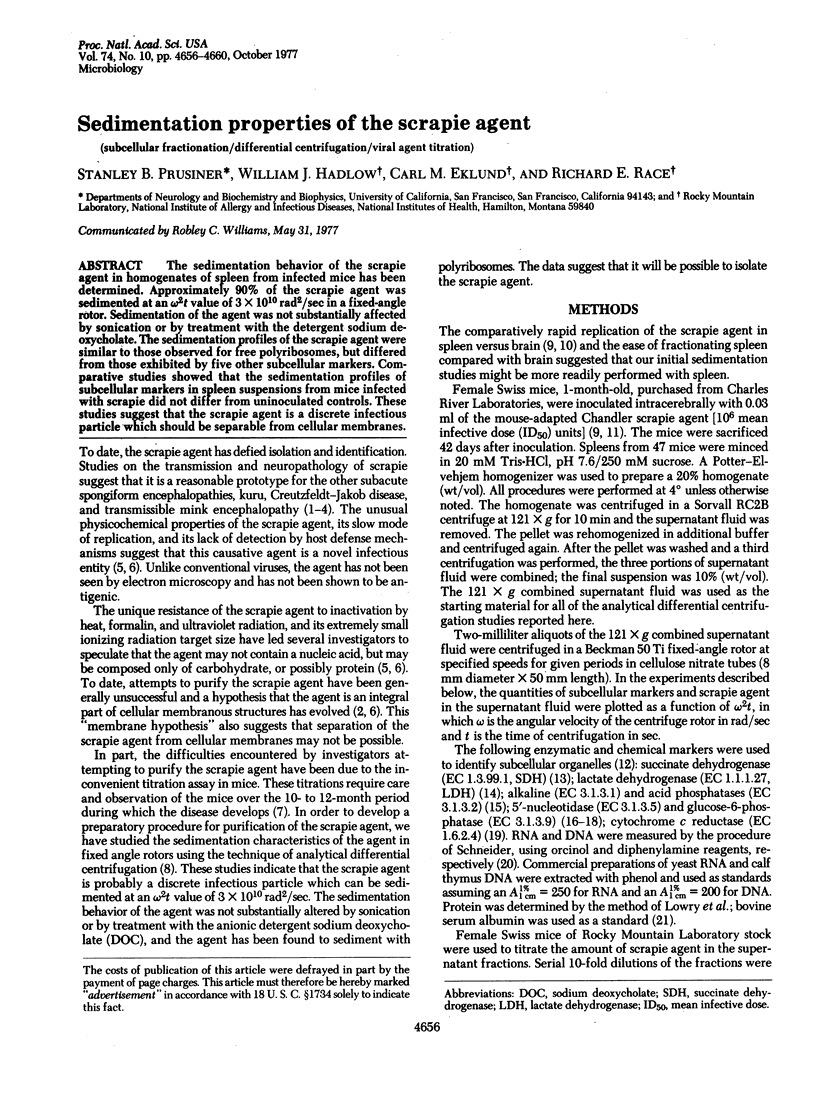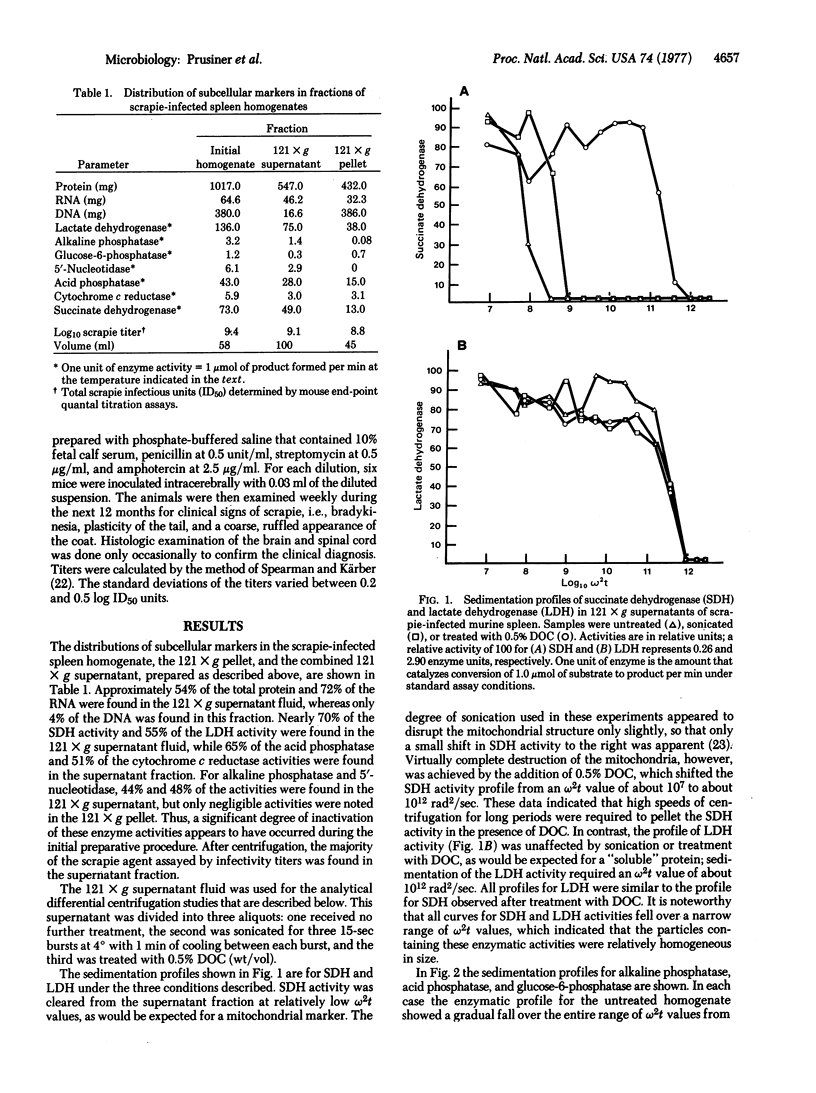Abstract
The sedimentation behavior of the scrapie agent in homogenates of spleen from infected mice has been determined. Approximately 90% of the scrapie agent was sedimented at an omega2t value of 3 X 10(10) rad2/sec in a fixed-angle rotor. Sedimentation of the agent was not substantially affected by sonication or by treatment with the detergent sodium deoxycholate. The sedimentation profiles of the scrapie agent were similar to those observed for free polyribosomes, but differed from those exhibited by five other subcellular markers. Comparative studies showed that the sedimentation profiles of subcellular markers in spleen suspensions from mice infected with scrapie did not differ from uninoculated controls. These studies suggest that the scrapie agent is a discrete infectious particle which should be separable from cellular membranes.
Full text
PDF




Selected References
These references are in PubMed. This may not be the complete list of references from this article.
- Alper T., Haig D. A., Clarke M. C. The exceptionally small size of the scrapie agent. Biochem Biophys Res Commun. 1966 Feb 3;22(3):278–284. doi: 10.1016/0006-291x(66)90478-5. [DOI] [PubMed] [Google Scholar]
- Anderson N. G. Analytical techniques for cell fractions. 8. Analytical differential centrifugation in angle-head rotors. Anal Biochem. 1968 Apr;23(1):72–83. doi: 10.1016/0003-2697(68)90010-9. [DOI] [PubMed] [Google Scholar]
- Bignami A., Parry H. B. Aggregations of 35-nanometer particles associated with neuronal cytopathic changes in natural scrapie. Science. 1971 Jan 29;171(3969):389–390. doi: 10.1126/science.171.3969.389. [DOI] [PubMed] [Google Scholar]
- Blobel G., Potter V. R. Nuclei from rat liver: isolation method that combines purity with high yield. Science. 1966 Dec 30;154(3757):1662–1665. doi: 10.1126/science.154.3757.1662. [DOI] [PubMed] [Google Scholar]
- Blobel G., Potter V. R. Studies on free and membrane-bound ribosomes in rat liver. I. Distribution as related to total cellular RNA. J Mol Biol. 1967 Jun 14;26(2):279–292. doi: 10.1016/0022-2836(67)90297-5. [DOI] [PubMed] [Google Scholar]
- CHANDLER R. L. Encephalopathy in mice produced by inoculation with scrapie brain material. Lancet. 1961 Jun 24;1(7191):1378–1379. doi: 10.1016/s0140-6736(61)92008-6. [DOI] [PubMed] [Google Scholar]
- David-Ferreira J. F., David-Ferreira K. L., Gibbs C. J., Jr, Morris J. A. Scrapie in mice: ultrastructural observations in the cerebral cortex. Proc Soc Exp Biol Med. 1968 Jan;127(1):313–320. doi: 10.3181/00379727-127-32680. [DOI] [PubMed] [Google Scholar]
- Eklund C. M., Hadlow W. J. Implications of slow viral diseases of domestic animals for human disease. Medicine (Baltimore) 1973 Jul;52(4):357–361. doi: 10.1097/00005792-197307000-00014. [DOI] [PubMed] [Google Scholar]
- Eklund C. M., Kennedy R. C., Hadlow W. J. Pathogenesis of scrapie virus infection in the mouse. J Infect Dis. 1967 Feb;117(1):15–22. doi: 10.1093/infdis/117.1.15. [DOI] [PubMed] [Google Scholar]
- Huang C. H., Keyhani E., Lee C. P. Fractionation by sucrose density gradient centrifugation of membrane fragments derived by sonic disruption of beef heart mitochondria. Biochim Biophys Acta. 1973 May 30;305(2):455–473. doi: 10.1016/0005-2728(73)90191-6. [DOI] [PubMed] [Google Scholar]
- Hunter G. D., Kimberlin R. H., Millson G. C. Absence of eclipse phase in scrapie mice. Nat New Biol. 1972 Jan 5;235(53):31–32. doi: 10.1038/newbio235031a0. [DOI] [PubMed] [Google Scholar]
- Hunter G. D., Kimberlin R. H., Millson G. C., Gibbons R. A. An experimental examination of the scrapie agent in cell membrane mixtures. I. Stability and physicochemical properties of the scrapie agent. J Comp Pathol. 1971 Jan;81(1):23–32. doi: 10.1016/0021-9975(71)90051-x. [DOI] [PubMed] [Google Scholar]
- Hunter G. D. Scrapie: a prototype slow infection. J Infect Dis. 1972 Apr;125(4):427–440. doi: 10.1093/infdis/125.4.427. [DOI] [PubMed] [Google Scholar]
- Kimberlin R. H., Millson G. C., Hunter G. D. An experimental examination of the scrapie agent in cell membrane mixtures. 3. Studies of the operational size. J Comp Pathol. 1971 Jul;81(3):383–391. doi: 10.1016/0021-9975(71)90026-0. [DOI] [PubMed] [Google Scholar]
- LOWRY O. H., ROSEBROUGH N. J., FARR A. L., RANDALL R. J. Protein measurement with the Folin phenol reagent. J Biol Chem. 1951 Nov;193(1):265–275. [PubMed] [Google Scholar]
- Lamar C. H., Gustafson D. P., Krasovich M., Hinsman E. J. Ultrastructural studies of spleens, brains, and brain cell cultures of mice with scrapie. Vet Pathol. 1974;11(1):13–19. doi: 10.1177/030098587401100102. [DOI] [PubMed] [Google Scholar]
- McIntosh P. R., O'Toole K. The interaction of ribosomes and membranes in animal cells. Biochim Biophys Acta. 1976 Oct 26;457(2):171–212. doi: 10.1016/0304-4157(76)90010-1. [DOI] [PubMed] [Google Scholar]
- Siakotos A. N., Gajdusek D. C., Gibbs C. J., Jr, Traub R. D., Bucana C. Partial purification of the scrapie agent from mouse brain by pressure disruption and zonal centrifugation in sucrose-sodium chloride gradients. Virology. 1976 Mar;70(1):230–237. doi: 10.1016/0042-6822(76)90261-0. [DOI] [PubMed] [Google Scholar]
- Singer T. P. Determination of the activity of succinate, NADH, choline, and alpha-glycerophosphate dehydrogenases. Methods Biochem Anal. 1974;22:123–175. doi: 10.1002/9780470110423.ch3. [DOI] [PubMed] [Google Scholar]


